

Vol. 39 (Number 16) Year 2018 • Page 38
Svetlana Nikolaevna ZOLNIKOVA 1; Anatoliy Dmitrievich KOT 2; Juletta Albertovna RUVINKAYA 3
Received: 28/02/2018 • Approved: 05/03/2018
ABSTRACT: Under the conditions of an unfavorable global market situation, changes in exchange rates, as well as a drop in global energy prices, the efficiency of production activities plays an important role in the life of an enterprise, since ensuring it, the leadership can make a decision related to the management, coordination or optimization of the enterprise. Therefore, the effectiveness of production is necessary for the timely identification and elimination of shortcomings in the corporate development, the identification of reserves, the improvement of the corporate financial condition and ensuring its financial stability. The issue of sustainable development of an oil transportation enterprise is comprehensive. The paper substantiates D. Scott Sink's method of assessing the production efficiency of an oil transportation enterprise, the introduction of the LCC (life cycle cost) analysis for cost accounting, and the application of a program-targeted approach to solving the tasks put. This will help to improve the efficiency of production activities through a more detailed assessment, identification and elimination of weaknesses in production. |
RESUMEN: Bajo las condiciones de una situación desfavorable del mercado global, cambios en los tipos de cambio, así como una caída en los precios mundiales de la energía, la eficiencia de las actividades de producción juega un papel importante en la vida de una empresa, ya que asegurándola, el liderazgo puede hacer una decisión relacionada con la gestión, coordinación u optimización de la empresa. Por lo tanto, la efectividad de la producción es necesaria para la identificación oportuna y la eliminación de deficiencias en el desarrollo corporativo, la identificación de reservas, la mejora de la situación financiera corporativa y la garantía de su estabilidad financiera. La cuestión del desarrollo sostenible de una empresa de transporte de petróleo es integral. El artículo corrobora el método de D. Scott Sink para evaluar la eficiencia de producción de una empresa de transporte de petróleo, la introducción del análisis LCC (costo del ciclo de vida) para la contabilidad de costos y la aplicación de un enfoque dirigido a programas para resolver las tareas planteadas. Esto ayudará a mejorar la eficiencia de las actividades de producción a través de una evaluación más detallada, identificación y eliminación de debilidades en la producción. |
The problem of sustainable development of the enterprise in the conditions of the radical reforming of the Russian economy is directly related to the issue of the efficiency of production activities. It took not just radical changes in views on this problem, but a change in the whole paradigm of the effectiveness of the organization. The complex classification of factors that affect the efficiency of the enterprise production activity allows modeling those activities, and searching for production reserves to improve the efficiency of operations. External factors which are practically not regulated by the enterprise, and internal, which are part of the entire environment of the enterprise within the production framework (Figure 1) were specified. External factors do not depend on the activity of the enterprise, but quantify the level of use of production and financial resources of the enterprise.
Figure 1
External factors affecting the efficiency of production
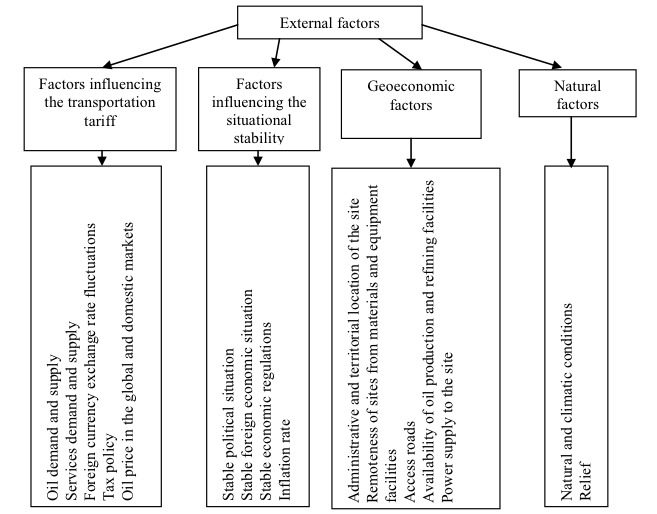
External factors affect the total parameters and theoretically determine the enterprise’s performance but may be not related to the essence of the parameter considered (Figure 2).
Figure 2
External factors affecting the efficiency of production
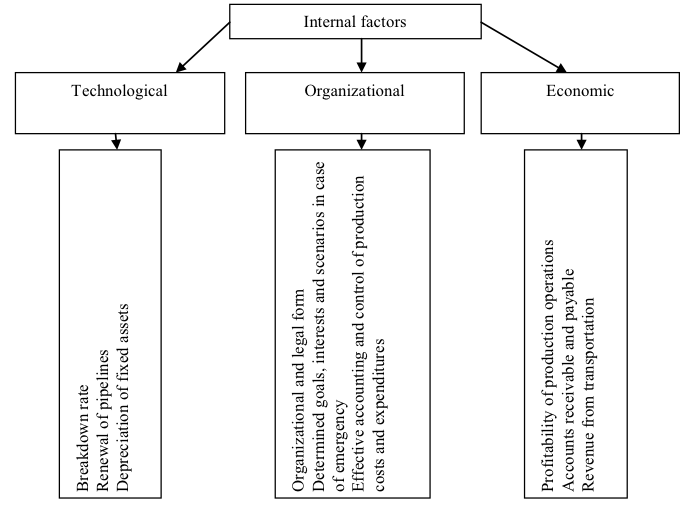
The classification of the factors and the improvement of the methods for their analysis allow solving an important problem – clearing the main indicators from the influence of external and side factors so that the indicators taken to assess the performance of the enterprise objectively reflect its achievements. In order to identify which of the factors has the greatest impact on the efficiency of the enterprise's production activity, it will be useful to analyze how the change in these criteria affected the production efficiency (Figures 3, 4).
Figure 3
Dynamics of profitability of production operations, %
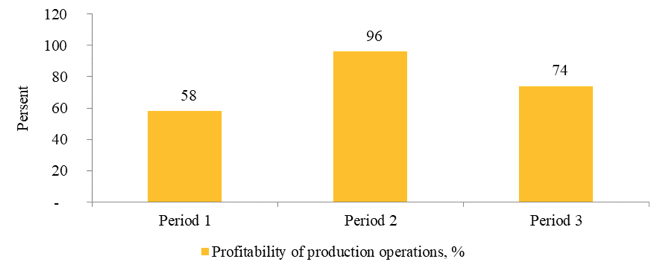
------
Figure 4
Dynamics of the core performance indicators, thousand rubles
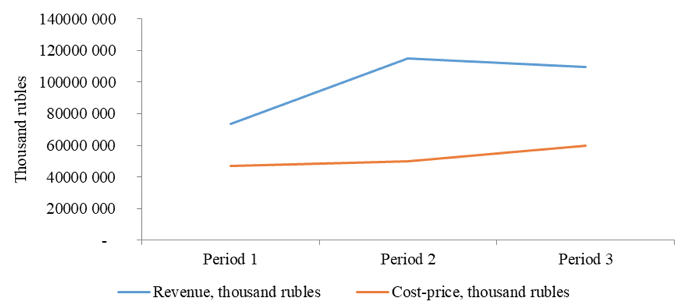
The decrease in revenue by 30%, the unstable growth in profitability of production activities, the growth in the cost of services provided by 9%, the increase in accidents, and the increase in the depreciation rate of fixed assets by 5% lead to the conclusion that the efficiency of production activities is declining. In addition, problems are observed in all three internal factors affecting the efficiency of production activities: among technological, it will be the breakdown rate, among organizational – the efficiency of accounting and control over production costs and expenses, and among economic – the profitability of production activities. It will be advisable to analyze how an enterprise performance assessment is conducted.
At an oil transportation enterprise, comprehensive assessment of its activities is used. Production activity is evaluated through comparison methods (comparison by a given criterion in dynamics, comparison with the sector average, etc.). However, this assessment is made only at the level of the organization itself, while structural levels, such as LODS (liner operating dispatcher station), departments, employees, are involved indirectly and unilaterally. It was revealed that some of the important indicators (the number of small and large violations by the employee, the number of emergency stops of individual sections, investments at the organization’s level) were not taken into account, which could affect the results of production efficiency. Thus, a comprehensive assessment of the enterprise production activities is required, taking into account the shortcomings of the assessment method used.
The organizational internal factors include the effectiveness of cost management which needs to be paid attention to. At the moment, in order to comply with international standards, the enterprise uses benchmarking and standard-costing. However, when applying these methods, due attention is not paid to the costs of equipment repairs, although this cost item can significantly affect the cost price (Lenkova, & Osinovskaya, 2015). The standards of indicators are applied only for a short period of time and in unfavorable market conditions they cannot display the dynamics for a long period, and not all general methods can be applied to the enterprise, which can lead to a discrepancy between the goals set by the enterprise and the results. Thus, there is some uncertainty in the accounting of costs and there is no comprehensive information used, which can lead to a distortion of the real picture of the enterprise costs and a difficulty in finding the true cause of the increase in the cost-price.
One of the indicators of the technological factor is the breakdown rate, which affects the costs of the enterprise, since funds are required to eliminate the breakdown, replace the pipeline, and prevent environmental pollution (an average of about 3 million rubles for the elimination of one accident). The problem of breakdowns on oil pipelines is a global issue, so its solution is considered at the level of the corporate strategy. In addition to the costs that are required to eliminate breakdowns, it should also be noted that there are costs associated with the loss of a certain amount of oil as a result of the pipeline leaks. It can be seen that the number of breakdowns directly affects the amount of payments for the liquidation of a breakdown (Figure 5).
Figure 5
Dynamics of breakdowns and costs on their elimination
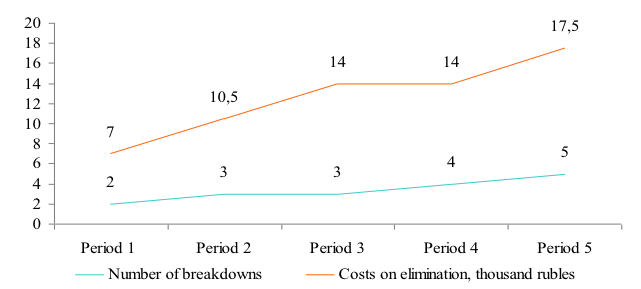
When analyzing the causal relationship of breakdowns and searching for the root cause, it was revealed that one of the main causes of frequent accidents was the depreciation of fixed assets (Figure 6). The solution to this problem can be the replacement of high-risk oil pipelines.
To solve the problems encountered at the enterprise, a number of measures are proposed that will help to influence the production activity of the enterprise.
• applying Sink’s method to assess the effectiveness of production activities;
• doing cost accounting using LCC analysis;
• using the program-targeted approach to solve problem situations, such as replacing high-risk oil trunk pipelines.
The advantage of Sink’s assessment method is a clear division into subsystems, which allows one to understand how certain indicators of each level affect the production activity of the organization (Strowski, 2016). Thus, it will be possible to more comprehensively assess the activities of the enterprise and work out its own development strategy at the level of the organization, branch and department. It will also be useful to find out the reasons for the unstable growth in profitability (Bolodurin, & Konysheva, 2012) and the growth in the cost of services.
Figure 6
Ishikawa diagram. Causal relationships of breakdowns at the pipeline transport
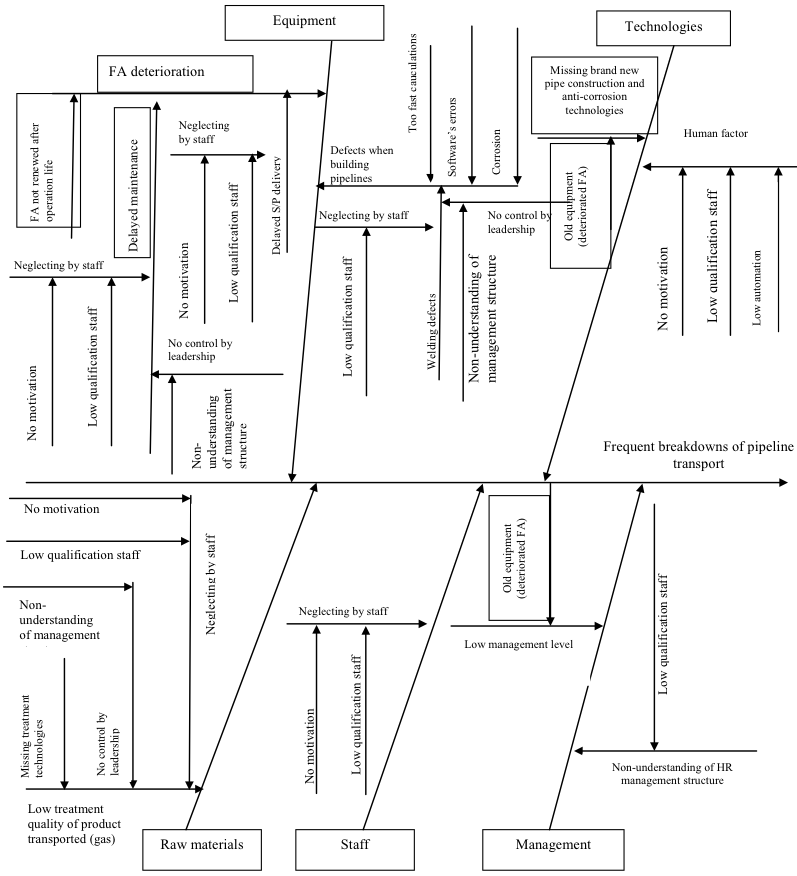
Having considered the change in the components of the profitability indicator, it was concluded that the cost-price of the provided service is subject to stable growth. Therefore, it is advisable to pay attention to the effectiveness of costs management in order to optimize them and ultimately ensure stable financial condition of the enterprise. Thus, it will be appropriate to consider the structure of the costs of the service provided to identify the reason for the cost-price increase.
One of the important indicators influencing profitability is the cost, which, in turn, largely consists of the cost of oil transportation services, the portion of which has recently increased. Having considered the structure of transportation services, it can be concluded that there is an increase in other costs, a significant portion of which is spent on the elimination of breakdowns.
The largest portion in the cost structure is taken up by the cost of oil transportation services, and the volume of these services tends to increase. Having studied the structure of oil transportation services in dynamics (Figure 7), one should pay attention to the following. Over the past year, the biggest increase in costs occurred in depreciation (by 37%) due to the commissioning of a new oil pipeline. There was also a significant increase in other costs (by 22%), which included the costs of liquidating a breakdown. During the analyzed period, there was a significant increase in the cost of oil transportation services by 8.5%. The reason for the increase in these costs is an increase in tariffs by about 7% compared to the previous year.
Figure 7
Cost-price structure of the services of the oil transportation enterprise
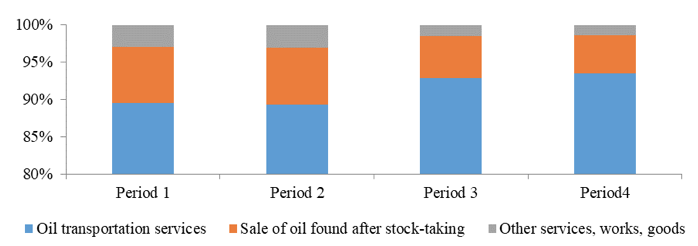
The cost accounting systems used by the company do not pay enough attention to the costs on the elimination of breakdowns (Lenkova, & Osinovskaya, 2015; Gazeev et al., 2013), but the use of the LCC analysis will allow specifying single and periodic costs at each stage of service providing and subsequently compare them with the corresponding revenues (Oko, & Gomolka, 2013; Auditor Report on Accounting Statements of AO "Transneft – Sibir" for 2013-2016, n.d.; Balance Sheet of AO "Transneft – Sibir" as on December 31, 2013, n.d.; Efficiency Ratio, n.d.; Electronic Scientific Journal "Oil and Gas Business"], No. 3. (2013). This will also identify the most vulnerable stages in the life cycle of the service provided and the reasons for their occurrence. The main share of the periodic costs is the costs of repair and elimination of breakdowns, one of the reasons for which is depreciation of the FA (fixed assets). The solution to this problem can be the replacement of high-risk oil pipelines.
Since elimination of this problem will be time-consuming in the course of the natural functioning of the system, it will be necessary to apply a management method that will ensure special program measures, concentrate efforts and mobilize resources seeking to solve the problem. At the moment, the enterprise uses the systematic approach. However, it is not effective enough in the face of an ever-changing market situation, since constant changes are required taking into account the new conditions, and does not allow evaluating the effectiveness of strategic activities. In the authors’ opinion, the use of the program-targeted approach (Savitskaya, 2014) will be useful as it will allow increasing the efficiency of distribution and use of budgetary funds, and also solving the problems of breakdowns. The program-targeted approach in management is an approach where the manager is oriented toward achieving the final result in the logic of step-by-step actions: formation of a goal tree, development of an adequate executing program, and implementation of the management program. Within the program-targeted approach, the differentiation of goals is essential in the organization of management, since the choice of such an approach depends on the nature of the goal being realized, which can also be implemented by combining the program-targeted approach with other organizational principles. Proceeding from the above, the program-targeted approach will allow developing a program for solving the problem of frequent breakdowns on the basis of the orientation toward achieving the main goal and optimization of the resources required for that.
For the introduction of the program-targeted approach, changes were made in the management structure of the organization, since the employees of the enterprise will become members of the expert group on the program-targeted approach. These employees will not be assigned from their current places of work, but will receive increments for an increase in the amount of work at a rate of 20 percent of the salary during the program. Costs were calculated in the form of an increment to the salary of participants in the program during the project (Table 1).
Thus, the salary costs for employees involved in the implementation of the program will amount to 93,430 rubles, which will be more profitable than recruiting new employees. Over the year, it will be 1,121,160 rubles, being 5,605,800 rubles over the period of program’s implementation (5 years).
Table 1
Change in payroll during the implementation of the program on breakdown-free
operation of the oil transportation enterprise, thousand rubles
Employee |
Salary |
Salary + 20% |
Increment |
Insurance |
Payroll |
Change |
Deputy General Director |
84.00 |
100.80 |
12.60 |
34.02 |
147.42 |
21.84 |
Chief economist |
63.00 |
75.60 |
9.45 |
25.52 |
110.57 |
16.38 |
Chief engineer |
60.00 |
72.00 |
9.00 |
24.30 |
105.30 |
15.60 |
Head of department |
59.00 |
70.80 |
8.85 |
23.90 |
103.55 |
15.34 |
Head of division |
48.00 |
57.60 |
7.20 |
19.44 |
84.24 |
12.48 |
Head of LODS |
45.00 |
54.00 |
7.10 |
19.19 |
80.29 |
11.79 |
Total |
93.43 |
|||||
To implement the program-targeted approach, a scheme for solving the breakdown problem was also developed. The variant of the solution of the problem, which includes the following measures, has been chosen:
- predicting the possibility of breakdowns;
- replacement of pipes with finished service life;
- introduction of modern anticorrosive methods of isolation;
- doing preventive repair according to the plan;
- calculation of the reserve for the liquidation of breakdowns caused by the natural factor.
It should be noted that the program-targeted approach will also be able to solve new problems that will arise in the organization.
Owing to the measures proposed, the number of breakdowns will be reduced. The total cost price will be reduced by almost 5% (Figure 8).
Figure 8
Change in the total cost in comparison with the base, thousand rubles

The profitability of production operations taking into account the above measures will be 67.9%, which means that it will increase by 4% (Figure 9).
Figure 9
Change in the profitability of production operations, total cost in comparison with the base, %

The net profit will increase by 0.4%, while the number of breakdowns - by 38.5% (Figure 10).
Figure 10
Change in the net profit in comparison with the base, thousand rubles
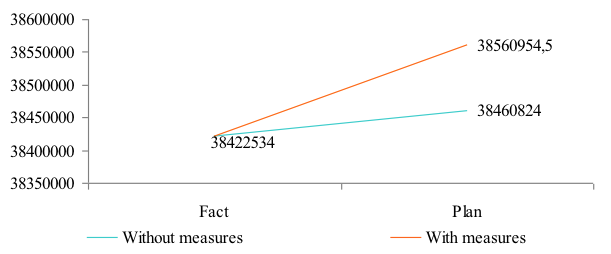
The proposed program-targeted approach can address not only the problems of breakdowns, but any other problems that affect the corporate strategic goals. Therefore, one can say that the proposed approach and the scheme for solving problems are universal and can be used not only for oil transportation enterprises, but for pipeline transport in general, or any other organization.
The proposed program-targeted approach to solve the breakdowns problems, based on Sink’s method to assess the efficiency of the production operations of an oil transportation enterprise and the LCC analysis, was developed and proposed for testing and further implementation at the oil transportation enterprise. The implementation of the authors’ approach ensures:
˗ analysis of important indicators that can significantly influence the results of production operations at all corporate structural levels;
˗ more complete and comprehensive assessment of the activities of the oil transportation enterprise;
˗ development of a program to address the problem of frequent breakdowns, based on the achievement of the main goal and optimization required for this resource.
The proposed program-targeted approach can address not only the problems of breakdowns, but any other problems that affect the corporate strategic goals. Also, this approach and the problem-solving scheme are universal and can be used not only for oil transportation enterprises, but for the pipeline transport in general, or any other organization. Its application is not limited to strict regulatory frameworks – the management of the enterprise has the opportunity to build its own combination of the system of variants evaluated from the proposed range of goals and its technological development.
Various aspects that affect the efficiency of production operations are considered in the works by many domestic and foreign researchers (Riley, 2012; Oko, & Gomolka, 2013; Gazeev et al., 2013; Lenkova, & Osinovskaya, 2015; Annual Report of AO "Transneft – Sibir" for 2015 and 2016, n.d.; Lean Production, n.d.; Profit and Loss Statement for 2013 of AO "Transneft-Sibir", 2013-2016, n.d.; Resolution by the Federal Energy Commission of the RF No. 42-e/5, 2002; Explanatory Note to the Balance Sheet and Profit and Loss Statement of AO "Transneft – Sibir" for 2013-2016, (n.d.); Production Efficiency, n.d.; Program for Strategic Development of OAO "AK Transneft" until 2020, n.d.); Production and Commercial Operations of the Enterprise, n.d.; Production Plan of AO "Transneft – Sibir" for 2016 and 2017, n.d.).; Collection No. 4 of the Consolidated Indices of Replacement Value of Buildings and Structures of the Oil Industry for the Revaluation of Fixed Assets, 1970); Structure of AO "Transneft – Sibir", n.d.)
Currently, there is a wide range of tools to assess the effectiveness of production operations, as well as to improve it (Strowski, 2016). In this case, as a rule, the basic methods are not always suitable for the production conditions in a given situation at a particular enterprise. So, for example, the techniques that are effective in foreign companies are ineffective when applied in Russian companies and require further development and integration in the local production conditions. In this paper, the authors offer an example of the adaptation of methods and approaches to Russian enterprise, as well as the analysis of the implementation results.
To date, oil is an important component in the global economy. It is not just raw material for the production of many synthetic materials, but also fuel, which means it is necessary for the production of the whole galaxy of other products. Practically, the only mode of transportation of this particular kind of cargo is the oil pipeline.
In the unfavorable conditions of the world market, as well as after the drop in world energy prices, the efficiency of production activity plays an important role in the life of an enterprise. It is necessary for timely detection and elimination of shortcomings in the development of the enterprise, identifying reserves and improving the financial condition. However, after analyzing the main performance indicators of the enterprise, decrease in the efficiency of production operations was detected. Therefore, it was expedient to analyze the factors influencing the efficiency of production operations to solve this problem.
It was proposed to solve this problem using the program-targeted approach. To implement the program-targeted approach, a scheme for solving the breakdowns problem was developed. In order to obtain more complete assessment of the efficiency of production operations, the use of Sink's method of efficiency evaluation was proposed. The advantage of this evaluation method is a clear division into subsystems, which allows one to understand how certain indicators affect the production operations of the organization. In this regard, a system of indicators for each level was developed. This will allow identifying the existing deviations and those possible in the future at an early stage to prevent them. For long-term evaluation of the costs incurred and their coverage by corresponding revenues, the correlation of these indicators with respect to the product as a whole, as well as providing a strategic vision of the cost structure and its comparison with the revenue structure, it is suggested to use the LCC analysis. It involves the specification of one-time and recurring costs and the identification of costs at each stage in the provision of services, then compared with the corresponding revenues. This will identify the most vulnerable stages in the life cycle of the service provided and the reasons for their occurrence.
As the directions of further research, the authors see in-depth detail and the construction of adapted industry-specific features of the basic criteria for implementing the program-targeted approach depending on the stage of the life cycle of the enterprise and the sectoral market specifics.
Auditorskoe zaklyuchenie po bukhgalterskoi otchetnosti AO "Transneft – Sibir" za 2013-2016 gg. [Auditor Report on Accounting Statements of AO "Transneft – Sibir" for 2013-2016]. (n.d.).
Bolodurina, M.N., & Konysheva, K.A. (2012). Sistema pokazatelei otsenki effektivnosti deyatelnosti predpriyatii v sostave neftegazovogo kholdinga [System of Indicators to Assess the Performance of Operations of Enterprises within an Oil and Gas Holding]. Retrieved May 15, 2017, from https://cyberleninka.ru/article/n/sistema-pokazateley-otsenki-effektivnosti-deyatelnosti-predpriyatiy-v-sostave-neftegazovogo-holdinga
Bukhgalterskii balans na 31 dekabrya 2013 goda AO "Transneft – Sibir" [Balance Sheet of AO "Transneft – Sibir" as on December 31, 2013]. (n.d.).
Efficiency Ratio. (n.d.). Retrieved May 15, 2017, from http://www.investopedia.com/terms/e/efficiencyratio.asp#ixzz4jdaRXclz
Elektronnyi nauchnyi zhurnal "Neftegazovoe delo" [Electronic Scientific Journal "Oil and Gas Business"], No. 3. (2013). Retrieved April 27, 2017, from http://ogbus.ru/years/32013/
Gazeev, M.H., Volynskaya, N.A., & Lenkova, O.V. (2013). Implementation of the Life Cycle Concept in Strategy Development of Oil Company. World Applied Sciences Journal, 24(5), 644-648.
Godovoi otchet AO "Transneft-Sibir" 2015 g. i 2016 g. [Annual Report of AO "Transneft – Sibir" for 2015 and 2016]. (n.d.).
Lean Production. (n.d.). Retrieved April 13, 2017, from https://www.tutor2u.net/business/reference/introduction-to-lean-production
Lenkova, O.V., & Osinovskaya, I.V. (2015). Conceptual Framework of Benchmarking in Russian Oil and Gas Companies. Asian Social Science, 11(5), 258-273.
Oko, J.P., & Gomolka, G. (2013). Increasing Production Efficiency. Back to Basics: The Five Steps. Stellar. Retrieved April 21, 2017, from https://www.stellar.net/media/83200/Stellar_Increasing_Production_Efficiency.pdf
Otchet o finansovykh rezultatakh za 2013 god AO "Transneft – Sibir", 2013-2016 gg. [Profit and Loss Statement for 2013 of AO "Transneft-Sibir", 2013-2016]. (n.d.).
Postanovlenie FEK RF ot 10.07.2002 No. 42-e/5 "Ob utverzhdenii "Metodiki opredeleniya tarifov na transportirovku nefti po magistralnym truboprovodam Rossiiskoi Federatsii" [Resolution by the Federal Energy Commission of the RF No. 42-e/5 "On Approval of the Methodology to Determine the Tariffs on Oil Transportation via Trunk Pipelines of the Russian Federation]. (2002, July 10). Retrieved May 15, 2017, from http://zakonbase.ru/content/part/43589
Poyasnenie k bukhgalterskomu balansu i otchetu o finansovykh rezultatakh AO "Transneft – Sibir za 2013-2016 gody" [Explanatory Note to the Balance Sheet and Profit and Loss Statement of AO "Transneft – Sibir" for 2013-2016]. (n.d.).
Production Efficiency. (n.d.) Retrieved May 25, 2017, from https://www.tutor2u.net/business/reference/production-efficiency
Programma strategicheskogo razvitiya OAO "AK "Transneft" na period do 2020 goda [Program for Strategic Development of OAO "AK Transneft" until 2020]. (n.d.).
Proizvodstvenno-khozyaistvennaya deyatelnost predpriyatiya [Production and Commercial Operations of the Enterprise]. (n.d.). Retrieved March 23, 2017, from http://www.kakprosto.ru/kak-848538-proizvodstvenno-hozyaystvennaya-deyatelnost-predpriyatiya#ixzz4jjb6pnkr
Proizvodstvennyi plan AO "Transneft – Sibir" na 2016 i 2017 gody [Production Plan of AO "Transneft – Sibir" for 2016 and 2017]. (n.d.).
Riley, J. (2012). Production – Improving Efficiency. Retrieved March 8, 2017, from https://www.tutor2u.net/business/gcse/production_efficiency_improvements.htm
Savitskaya, G.V. (2014). Analiz khozyaistvennoi deyatelnosti predpriyatiya [Analysis of Business Activities of the Enterprise] (6th ed., revised). Minsk: Novoe znanie.
Sbornik No. 4 ukrupnennykh pokazatelei vosstanovitelnoi stoimosti zdanii i sooruzhenii neftyanoi promyshlennosti dlya pereotsenki osnovnykh fondov [Collection No. 4 of the Consolidated Indices of Replacement Value of Buildings and Structures of the Oil Industry for the Revaluation of Fixed Assets]. (1970). Moscow. Retrieved April 27, 2017, from http://upvs.kwinto.ru/interpr.php?link=_11157700.htm
Strowski, S. (2016). 8 Ways to Increase Productivity on the Manufacturing Floor. Retrieved May 15, 2017, from http://www.mmsonline.com/blog/post/8-ways-to-increase-productivity-on-the-manufacturing-floor
Struktura AO "Transneft-Sibir" [Structure of AO "Transneft – Sibir"]. (n.d.). Retrieved April 27, 2017, from http://siberia.transneft.ru/about/structure
1. Federal State Budget Educational Institution of Higher Education "Industrial University of Tyumen", Russia; E-mail: z622@mail.ru
2. Federal State Budget Educational Institution of Higher Education "Industrial University of Tyumen", Russia
3. Federal State Budget Educational Institution of Higher Education "Industrial University of Tyumen", Russia